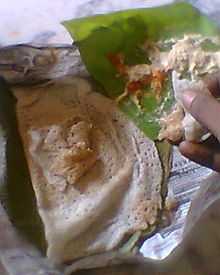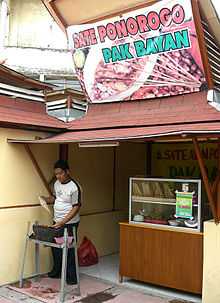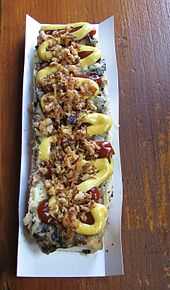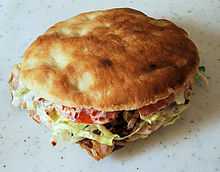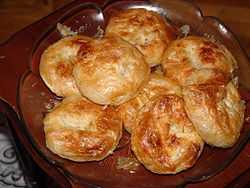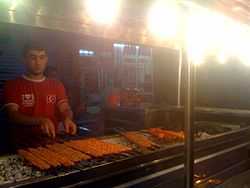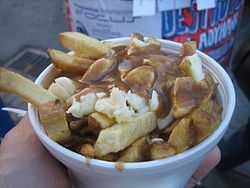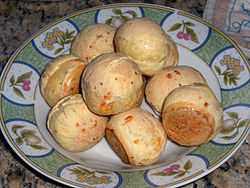List of street foods
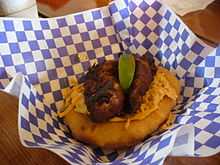
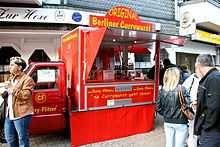
Street foods are consumed in many areas. Often sold by street vendors and peddlers, street food is usually ready-to-eat food or drink sold in a street or other public place, such as a market or fair, by a hawker or vendor, often from a portable stall.[1]
Street food vending is found around the world, but has variations within both regions and cultures.[2] For example, Dorling Kindersley describes the street food of Viet Nam as being "fresh and lighter than many of the cuisines in the area" and "draw[ing] heavily on herbs, chile peppers and lime," while street food of Thailand is "fiery" and "pungent with shrimp paste... and fish sauce" with New York City's signature street food being the hot dog, although the offerings in New York also range from "spicy Middle Eastern falafel or Jamaican jerk chicken to Belgian waffles."[3] In Hawaii, the local street food tradition of "Plate Lunch" (rice, macaroni salad and a portion of meat) was inspired by the bento of the Japanese who had been brought to Hawaii as plantation workers. [4]
Africa
Madagascar
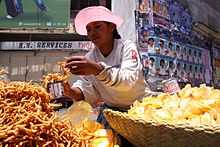
A variety of cakes and fritters collectively known as mofo are available from kiosks in towns and cities across Madagascar.[5] The most common is mofo gasy, "Malagasy bread", made from a batter of sweetened rice flour poured into greased circular molds and cooked over charcoal. Mofo gasy is a breakfast food and is often eaten with coffee, also sold at kiosks.[6] In coastal areas this mofo is made with coconut milk and is known as mokary.[7] Other sweet mofo include a deep-fried doughnut called menakely[8] and a fried dough ball called mofo baolina,[9] as well as a variety of fruit fritters, with pineapple and bananas among the most common fruits used.[10] Savory mofo include ramanonaka, a mofo gasy salted and fried in lard,[11] and a fritter flavored with chopped greens, onions, tomatoes, and chilies called mofo sakay, "spicy bread."[12]
In marketplaces and gas stations one may find vendors selling koba akondro, a sweet made by wrapping a batter of ground peanuts, mashed bananas, honey, and corn flour in banana leaves and steaming or boiling the small cakes until the batter has set.[13] Peanut brittle, dried bananas, balls of tamarind paste rolled in colored sugar, deep-fried wonton-type dough strings called kaka pizon, meaning "pigeon droppings," are also eaten in neighboring Reunion Island, and home-made yogurts, are all commonly sold on the street.[14] In rural areas, steamed cassava or sweet potatoes are eaten, occasionally with fresh or sweetened condensed milk.[13]
Morocco
Typical street food includes bessara, crumbed liver, spicy sardines, and brochettes.[15]
Nigeria
Chin chin is a meal served in Nigeria and west Africa. Other Nigerian street foods include suya (barbecued meat), boli (roasted plantain), fried yam and fish, roasted corn, and akara and moi-Moi (fried or steamed bean cakes, respectively). Pure water or sachet water is also sold, frequently by children.
South Africa
In South Africa, boerewors and other braai foods are available in the street.[16] In townships, ethnic foods are available.
In Cape Town, the Gatsby, a baguette filled with meat (often bologna sausage), salad, cheese, and chips is sold as street food. It is said to have originated from a single restaurant.
Bunny chow is a scooped out loaf with fufu or atchar inside and with the scooped out bread placed on top.[17]
Asia
Bangladesh
Dhaka street food vendors sell pitha, chotpoti, puchka, jhalmuri, badam, and various fried items.[18]
China
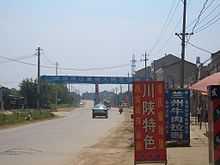
Street vendors of snack foods (xiaochi) are becoming less common as local governments cut down on the practice, citing safety and traffic congestion as problems. Many vendors have also moved towards opening small restaurants and shops, and "street food" is now commonly eaten indoors at established locations.[19]
Bing, a flatbread made of flour and fried in oil, was once a Northeastern street food that can also be found in many areas around the country. They can be served plain or stuffed with meat or eggs, or seasoned with scallions, sauces, or other flavours. One variety originating in Shandong and now found throughout China, jianbing guozi (煎饼果子), is made with the batter poured directly onto an iron skillet and evened out into a thin pancake. An egg is cracked on top, then various seasonings are added. It is rolled for portability.
Hong Kong
In Hong Kong notable foods include skewered beef, curry fish balls, stuffed peppers and mushrooms, and dim sum. Street side food vendors are called gaai bin dong (Chinese: 街邊檔; literally: "street side stalls"). Street food in Hong Kong can grow into a substantial business with the stalls only barely "mobile" in the traditional street food sense (see dai pai dong).
India
Each region of India has street food specialties.
In areas of Maharashtra, such as Pune, street food culture includes vada paav, sabudana vada, panipuri, ragda raav, kutchi daabeli, sevpuri, dahipuri, pav bhaji, egg bhurji, chanachur, buddhi ke baal, and gola.[20] Mumbai, Maharashtra, is where vada pav originated.
In Punjab, gol-gappy, kulcha, pathurey cholley, naan, and lachhey are common.
New Delhi's cuisine is highly influenced by its neighbours Uttar Pradesh, Haryana, and Punjab, as well as Mughalai cuisine. Vegetarian dishes include sabzi kachauri (sabzi is usually spicy potato curry; kachauri can be plain as well as stuffed), dahil bhalla, and various other varieties of chaat. Certain parts of Old Delhi which include Chandani Chowk and Chawri Bazar have numerous street food vendors who have been sold street food for three or more generations.[21]
Indonesia
Street foods are sold by hawkers peddling their goods on carts, bicycles, motorbikes, by five foot way (kaki lima) trader, or by road-side stalls with easy access from the street. The food being sold may include Indonesian food like nasi campur, nasi goreng, gado-gado, soups (such as soto ayam), satay, desserts and beverages like bubur kacang hijau, es cendol, and es cincau.
In most cities, it is common to see Chinese dishes such as bakpao (steamed buns with sweet and savoury fillings), bakmie (noodles), and bakso (meatballs) sold by street vendors and restaurants, often adapted to become Indonesian-Chinese cuisine. One common adaptation is that pork is rarely used since the majority of Indonesians are Muslims.
Pakistan
Some of the common items in Pakistan include bun kabab sandwiches, samosas, kulfi ice cream, popcorn, fried or grilled fish, sugar cane juice, chickpea juice ('sutthu), lemonade (limno paani), sliced coconut, dried fruits and nuts (almonds, peanuts, walnuts, figs, pine nuts, etc.), haleem, biryani, pakoras, falsa fruit (Grewia asiatica), grilled chicken (chicken charga), french fries (often called 'finger chips'), paan, gol guppay, spiced chickpeas (chana masala) and papri chaat.
Philippines
The most common Philippine street foods include fried squidballs, fishballs, and kikiam, a type of processed chicken and pork, served on a stick with a variety of dipping sauces.
Roadside stands also serve barbecued pork, chicken, and offal, such as pig's blood or dried chicken blood (colloquially Betamax, after its rectangular shape resembling the Betamax tape), chicken heads (helmet), chicken feet (adidas), pig's ears (tenga) and chicken intestines (isaw). Among more esoteric foods are balut and penoy (duck eggs with fetus and without, respectively), tokneneng and kwek-kwek (battered, deep-fried chicken and quail eggs similar to tempura) and deep-fried day-old-chick.[22]
Taiwan
Taiwan's street food sold at night markets is well known in Asia, especially that from the city of Tainan.
Thailand
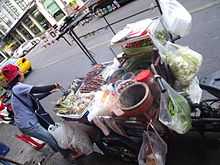
Noodle dishes include pad Thai; rat na, flat noodles with beef, pork, or chicken and vegetables, topped with a light gravy; and rad naa's twin, phat si-io, the same flat noodles dry-fried (no gravy) with a dark soy sauce, vegetables, meat, and chili.
Other dishes include tom yum kung (a soup), khao phat (fried rice), various kinds of satay, andvarious curries. Japanese chikuwa and German sausages have also appeared in Bangkok. Canal food has been sold from boats on Thailand's rivers and canals for over two centuries, but since the early 20th century King Rama V's modernizations have caused a shift towards land-based stalls. In Bangkok parlance, a housewife who feeds her family from a street food vendor is known as a "plastic-bag housewife", which originated from streets vendors packaging the food in plastic bags.
Vietnam
.jpg)
Pho was originally sold from elaborate carrying poles. From the pole hung two wooden cabinets, one housing a cauldron over a wood fire, the other storing noodles, spices, cookware, and space to prepare a bowl of pho. Today, however, pho is usually sold at fixed stands surrounded by tables and stools.[23]
Europe
Balkans
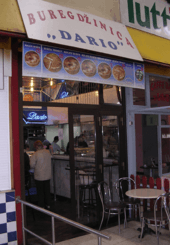
Street food in the Balkans is heavily influenced by the cuisine of the Ottoman Empire. Variations of the burek, a filled flaky pastry, are common throughout Turkey and the Balkans. Ćevapi is a sort of kebab served in Yugoslavia and Romania, where it is called mititei.
Benelux
In the Netherlands and Belgium, french fries are served with sauces such as mayonnaise, ketchup, curry, or tartar sauce (the latter mainly in Belgium). The combination of mayonnaise, ketchup or curry ketchup and chopped onions is called speciaal ("special"), and mayonnaise mixed with peanut sauce is called oorlog ("war").
Belgium
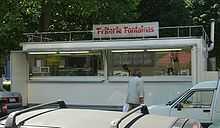
In Belgium, a thicker variety of fries is used, frieten in Dutch and frites in French. They are mainly sold by street vendors (see picture), in a little place called a frituur in Dutch, a friterie in French. In Belgium, French fries are traditionally fried in suet (beef fat) but this has become less common and people tend to fry them in oil. Liège-style waffles (Dutch wafel or French gaufre) are served warm as a street snack, somewhat similar to what is known in other countries as "Belgian waffles" (which are called in Belgium "Gaufres de Bruxelles" or "Brusselse Wafels") but richer, denser and sweeter. The pancake is fluffier than the French crêpe or the Russian blin.
Denmark
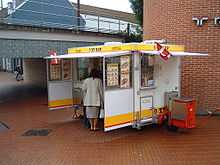
In Denmark, one can purchase sausages and hot dogs from sausage wagons. These are technically considered hot dog stands and are one of the most popular food trucks in the country.
Netherlands
In the Netherlands, the French fries are thinner and generally referred to as patat (the word for potato in the south of the Netherlands and in Flanders) or friet (from the French frire meaning deep-frying) or patat friet. Some shops in the Netherlands also sell Vlaamse friet (Flemish fries, similar to the type sold in Belgium) but this is less common than the thinner variant. In the Netherlands, French fries are traditionally fried in vegetable oil.
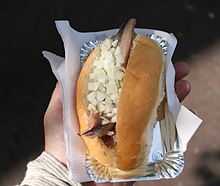
In the Netherlands, street foods are usually sold by a small store which is a mix of a cafe/bar and a fast-food restaurant, known as a snackbar or cafetaria. These stores may also contain the typically Dutch vending machine, an automatiek. While patat friet forms the main portion of the foods sold, many other items are also on offer including different types of deep-fried snack meats such as kroketten and frikandellen, and cheese snacks such as the kaassouffle (cheese deep fried inside a crispy bread crumb crust). Often, the product range includes other foods such as hamburgers, ice cream, bread rolls with different fillings, and occasionally pizza, falafel, doner kebab and shoarma. Also sold may be deep-fried Vietnamese spring rolls and other originally Asian and/or Surinamese snacks like bapao (a baozi filled with minced meat) and barra (a deep-fried savoury doughnut).
Street stalls also sell different fried, smoked and raw fish products, and are called a viskraam or haringkar (Dutch for "fish stall" or "herring cart)". Besides raw herring served with chopped onions sometimes with bread rolls and pickled cucumber, these stalls also sell fish products such as smoked mackerel, smoked eel and kibbeling (deep fried cod nuggets).
At festivals, markets and especially on New Year's Eve, street stalls around the country sell a type of beignets called oliebollen (literally 'oil balls'). They may also sell other sweet pastries such as waffles and apple beignets.
Czech Republic
The most common and traditional Czech street food is smažený sýr, which is a soft piece of cheese deep-fried and served on a hamburger bun.
Finland
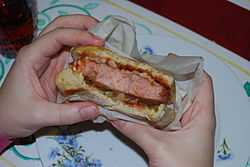
In Finland, street food can mostly be found at market squares and kiosks, although hamburger chains Hesburger, McDonald's, and Burger King are also available. A variety of savoury pastries such as lihapiirakka and karjalanpiirakka, and sweet pastries such as pulla, usually served with coffee, are very common. Fish stands at the market squares also serve cured salmon (graavilohi) on rye bread as an open sandwich or loimulohi. Regional specialties sold at the market squares include sultsina and kalakukko.
In addition to hamburgers and hot dogs, Finnish meat pastries with sausages are available at kiosks, especially a sausage sandwich called a porilainen. Condiments include ketchup, Finnish mustard, pickle relish, mayonnaise, and mustard relish, as well as lettuce, tomato, and onion. Other common late night street food fare found at kiosks are doner kebabs, Finnish meatballs (lihapulla), and french fries with condiments.
France
In France, sandwiches are a common street food. Most of them are baguette bread sandwiches with different kinds of fillings such as "jambon/beurre" (ham / butter), "jambon/fromage" (Ham with cheese) or "poulet/crudités" (chicken with vegetables).
Crêpes are another common French street food. A crêpe complète containing ham, shredded cheese, and an egg provides a filling lunch. Sweet crêpes or waffles are sold with Nutella and banana or Grand Marnier and sugar.
Other street foods include pizza, kebab-type sandwiches and panini, a grilled and pressed sandwich.
During the winter, roasted chestnuts can be bought.
Germany
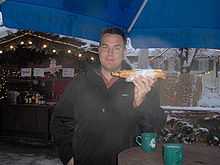
Bavarian Fleischkäse (also called Leberkäse), is similar to meatloaf, sliced to the thickness of a finger and generally served with either hot mustard or sweet mustard in a roll. Germany is also known for its various types of sausage, as well as the recent hybrid curry-sausage, currywurst. French fries (pommes in German, derived from French but pronounced according to German orthographic rules) are popular, served with ketchup and/or mayonnaise, and sometimes with sausage. Beer is sold at all sidewalk snack stands, which usually feature beers and small bottles of whiskey, schnapps, or vodka.
Turkish-influenced street foods include shawarma and Döner. North African stalls sell shawarma, falafel and halumi.
Hungary
Street food is not particularly common in Hungary, although gyros shops are becoming more common. Rétes (strudel) is fairly common, and lángos (a deep fried bread) is usually available at markets and during celebrations. In general, Hungarians looking for quick food will stop to sit down and eat, even if only at a Chinese buffet or a főzelékfaló (vegetable purée bar).
Italy
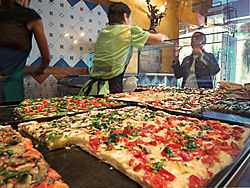
The most notable Italian street food is pizza, sold in take-aways and bakeries. Take-away pizza (or pizza al taglio) is quite different from pizzeria pizza. Unlike the round pizza normally found in restaurants, which originated in Naples as a street food itself, it is generally baked on large square trays, and square or rectangular portions are sold. It usually has quite a thick base, again unlike the traditional Italian restaurant pizza.
Toppings include margherita, mushrooms, Italian sausage, ham, and vegetables.
Other street foods are the Genoese focaccia di recco (a double layer of thin dough filled with quark cheese and baked); farinata (a thin, baked chickpea-flour batter, topped with salt, pepper and olive oil), which is often served with focaccia (a thin bread, also with salt and olive oil); Florentine trippa and lampredotto (ox stomach cooked in a seasoned broth and served in a bread roll); and Roman supplì; (rice balls filled with cheese and/or various fillings, covered in egg and breadcrumbs and deep fried), which is similar to Sicilian arancini, where the usual filling is a meat sauce with green peas.
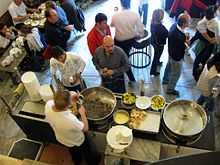
In Palermo, a street food would be Pani ca meusa (bread rolls with sliced, cooked pork spleen), and "panelle", deep-fried chickpea flour batter. In central Italy porchetta is common, which is a spicy roasted pork meat (from the whole, boned animal), usually served in a panino (bread roll).
In Naples, fried food stalls,friggitorie, sell filled, deep-fried pastries and other foods. A street food made of offal, commonly found in fairs and religious festivals in Naples and in the whole of Campania, is the 'O pere e 'o musso ("the paw and the muzzle"): calves' heads and pigs' feet are boiled, sliced and chopped, then seasoned with salt and lemon juice. This is also called musso re puorco ("pork muzzle"), although only calf heads are normally used.
Vendors sell watermelons during the summer months, as well as roasted chestnuts (caldarroste) stalls during the winter, and especially before Christmas.
Rosticcerie, while most often selling food to be eaten at home, also sometimes have a counter for immediate consumption of their goods, the most common of which are roast chicken, roast potatoes, fried polenta and other accompaniments.
Substantial immigration from Turkey and the Middle East has also gained shawarma (best known in Italy as kebab) an increasing popularity, as well as other middle-eastern traditional dishes.
Gelato (ice cream) is commonly available.
In the Romagna subregion, and especially in the Forlì-Cesena province, a flatbread called piadina is available. It is sold in kiosks, usually as a sandwich filled with mixed cold cut meats, cheese, and/or vegetables. A common variant is the crescione, a piadina cooked like a turnover; in this version the most common filling are tomato sauce with mozzarella, and pumpkin with boiled potato and sausage.
Malta
Pastizzi are small, ricotta cheese- or pea-paste- filled puff-pastry squares that can be bought from vendors in practically every village in Malta. Ricotta pastizzi (pastizzi tal-irkotta) are diamond-shaped with a hole in the middle where the ricotta stuffing can be seen, while pea pastizzi (pastizzi tal-pizelli) are of the same shape but are more like an envelope of puff pastry with no holes.
The shops selling these pastries are called pastizzeriji. They also sell items such as pies, pizza al taglio, sausage rolls, baked rice, baked macaroni (timpana), and sometimes arancini.
Another local street food found in such pastizzerias is the "qassatat". This is a ball-shaped pie crust with an open top, with the same two basic fillings of ricotta or peas, and sometimes a tuna and spinach mixture.
Imqaret are deep fried pastries filled with a mashed date mixture.
Hamburgers, hot dogs, and other such products being sold from vans, replace perennial Maltese favorites such as Ħobż biż-żejt, bigilla, and timpana.
Ħobż biż-żejt is usually bought from the inside of shops rather than stalls. This is the local sandwich, made from a local flat-bun called a ftira or a rounder one called hbejza which is filled with various ingredients available at the counter displays. The basic Ħobż biż-żejt recipe consists of filling the bread with oil and kunserva (tomato paste), tuna fish, pickles, and other delicacies which vary from shop to shop. These shops usually serve tea with milk in small glasses to their regulars.
Occasionally a street vendor will sell sinizza, a deep-fried ball of fish, batter, and other ingredients.
Poland
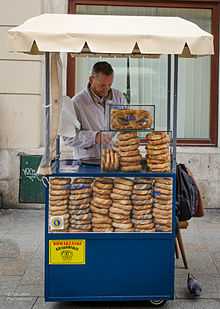
Popular street snacks in Poland include zapiekanki, essentially Polish-style French-bread pizzas with a variety of toppings; the obwarzanki of Kraków, which are like bagels (only with bigger holes); and precle (pretzels). The most common street food in Poland, seems to be lody, or ice cream. Long lines outside ice cream shops, and scores of pedestrians toting cones, are a regular fixture of Polish streetscapes.
Many fast food shops offer waffles (gofry), topped with whipped cream, powdered sugar, fresh fruit, or fruit jelly. Some of them also serve rurki z kremem, pipes similar to ice-cream cones, filled with whipped cream.
Hot dogs, hamburgers, and french fries are also very popular, often sold in the same shops and kiosks as zapiekanki. Pizza vendors commonly offer pizza in slices. Kebab (döner kebab in pita) vendors are also present and popular, as they are often open late in the night.
Romania
In Romania the most commonly available street foods during the day are covrigi, hot pretzels covered in sesame or poppy seeds, and plăcinte. "Plăcinte" can refer to sweet or savory pies with various fillings or to large pieces of fried dough eaten with garlic sauce, sour cream, cheese, or jam, similar to Hungarian lángos. In the south and along the Black Sea, plăcintă dobrogeană is available. This type of plăcintă is more like the burek encountered in other parts of the Balkans. Doughnuts called gogoși are also commonly available. At fairs and in the winter, kürtős kalács (tulnic in Romanian) with nuts or cinnamon is very popular. Mititei or mici, small grilled skinless sausages, are often available in the summer in marketplaces and at fairs. Other street foods include popcorn, steamed ears of corn, roasted chestnuts in winter, and ice cream in summer.
Russia
Traditional Eastern European items such as blini, pirozhki, and sausages are widely available.
The cuisine of Russia's Turkic minority is popular, with dishes like shawerma, rotisserie chicken, shashlik, chebureki, and plov (pilaf).
Kvas, a small beer made (usually) from bread, with honey being a frequent additive (medoviy kvass), is sold cold out of tanks or barrels on the street.
In areas with Chinese immigrant populations, Chinese dishes are sold.
Ice cream is enjoyed even on the coldest of Moscow days. Pizza is also available.
Kiosks sell candy, snacks, produce, beer and other beverages, and cigarettes and household products.
Slovakia
In Slovakia street offerings include steamed sweetcorn cobs, fried flat bread loaves with garlic and salt or other condiments (langos), fried buns with poppy seed, jam, or cream cheese filling (pirozky). Ice-cream is eaten in summer and roasted chestnuts in autumn. Ciganska pecienka (gypsy-style roasted pork), roasted sausage and more are sold at Saturday markets. Crepes and fresh sandwiches are available.
Spain
.jpg)
The concept of eating in the street is very rooted in the Spanish culture, even though in the last few decades the law has forbidden the sale of food in the streets due to hygiene concerns. The most common way to eat is still inside a bar with friends (tapeo), however, in winter, roast chestnuts can be bought in the street, especially in the north, and during fiestas, churros are also sold. Additionally, the typical bocadillo is the most common snack all around Spain for school children and workers. Bocadillos can be filled with various foodstuffs typical of the province (anchovies, sweet peppers, tortilla de patatas, tuna, ham, meat, cheese, Empanada Gallega, etc.) and are very convenient as "food on the go". Some major cities will have vendors selling ice cream, nuts and snacks from kiosks.
During summer in Málaga (and many small towns nearby), the fruit of the higo chumbo (a local cactus) is often sold.
Sweden
A very common street food in Sweden is hot dogs, and the traditional korvkiosk ("sausage kiosk") also often serve meatballs with mashed potatoes, brown sauce and lingonberry jam. Tunnbrödsrulle ("flatbread roll") is also often sold as street food. It is a soft flatbread normally filled with a sausage and mashed potato and sometimes with prawn sallad, lettuce and onion. Hamburgers and kebab are also popular street food.
Switzerland
Street foods available in Switzerland are sandwich-like, either the typical grilled panini, but also pretzels, grilled chicken, hot dogs or the traditional Bratwurst served with a slice of bread and sometimes mustard. Sweet foods include ice cream and crêpes. Stalls will typically be motorized trucks, rather than smaller wheeled carts.
Ukraine
Common Ukrainian street foods include various kinds of stuffed dumplings, such as perohy, varenyky and pyrizhky that are either boiled or fried and frequently served with a sour cream dill sauce. Fillings include mushrooms, onions, potatoes, ground meats and cabbage.[24] Holubsti, cabbage rolls with rice or meat filling and a tomato sauce are also frequently serves, particularly around the holiday of Easter.[24] Tartar influence can be found, particularly in the Crimea region with meat kabobs being popular.[24]
Kvass is a slightly fermented beverage made from rye bread, yeast and water. Dried apples and plums are steeped in sugar water which is then sold as a beverage called uzvar, particularly during festivals and fairs.[24]
United Kingdom
Converted or purpose built vans sell kebabs, baked potato, hamburgers and chips, especially at night. Individual portable ovens capable of being wheeled by a single man serve baked potatoes along with fillings such as cheese or chili con carne. On the coast fresh seafood is often sold straight from the catch cooked in mobile kitchens. At fairs, stalls sell candy floss and doughnuts. In Lancashire, hot parched peas (black peas) are bought from stalls, especially in the colder months. During winter there are stalls selling hot chestnuts. British street foods include fish and chips which are frequently sold and eaten out of a paper package.
The most common street food in the capital in earlier periods was jellied eels or pie and mash made from meat, which would be covered in the liquor from cooking the eels, although this tradition is no longer as common as in the early 20th Century.[25]
Ice cream vans are considered one of the signs of summer, and they usually play well-known tunes such as Greensleeves or Teddy Bears' Picnic through a PA system. Street carts can be seen in some cities selling products such as roast nuts and hot dogs, especially in places frequented by tourists.
Middle East
Turkey
In Turkey, street foods show considerable change from region to region. Here is a comprehensive list of most of the typical street foods that can be found around large Turkish metropolises:
Istanbul
- Döner served either in:
- Balik-Ekmek - freshly cooked fish served inside a bun of bread. This is typically served on the Eminonu square straight from the boat on which it is prepared.
- Pilav - steamed rice with chicken and chickpeas, mostly sold in steam carts at night
- Midye - mussels, that come in two forms:
- Midye Dolma - stuffed mussels with rice, pine nuts and raisins, eaten cold with lemon and olive oil
- Midye Tava - mussels on a skewer, that are fried in oil, and eaten with a garlic sauce
- Kokoreç - the Istanbul version is typically cooked on a pan rather than on charcoal, and can be spicy
- Uykuluk - sweetbread and other soft glands of lamb, grilled on charcoal, and especially popular in the European Side
- Patsos - a sandwich composed of fried french fries and sausage topped with kaşar, more than popular in the Asian Side
- Dilli Kaşarlı - a tiny toast comprising thin sliced smoked tongue with kaşar, a fine delicacy of Etiler
- Adana Kebabı - served in a dürüm
- Sucuk Ekmek - sucuk served in fresh crusty bread as a sandwich
- Islak Hamburger - another specialty of the Taksim neighbourhood, consisting of a garlic meatball in a tiny bun, that is dipped in a pepper sauce and reheated
- Kumpir - a baked potato filled to the maximum with a variety of toppings, popular around Ortaköy
- Boza - a fermented drink, drunk in winter nights
İzmir
- Kokoreç made exclusively from milk fed lamb, grilled on hot charcoal, served barely cleaved inside of a grilled bread quarter, with very little spice, often accompanied with cold beer
- Çöp Şiş - a kebab consisting of very small milk fed lamb cuts mounted on tiny skewers (made of dried squash) grilled on charcoal and served in very large numbers, around 15 at a time
- Kelle Söğüş - different parts, including cheek, tongue brain and eyes from a boiled sheep head, that are cooled and marinated in olive oil, then all chopped together and served wrapped in a lavaş with a slice of tomato and a hint of spice. It is considered to be a local delicacy of İzmir by excellence
- Közde Sandviç - Literally "Sandwich on Charcoal", that is bread toasted on a charcoal grill, alongside the meat and cheese that are grilled on charcoal to be then added to the toast. Comes in two main variations:
- Kumru - lit "the Dove", that consists of a lemon-shaped bread and has mostly a cheese filling
- Yengen - lit. "Your Aunt" that has a round and crusty bread with a meatier filling, with mayonnaise
- Midye - mussels, that come in two forms:
- Sardalya Tava - small sardines fried in olive oil
- Boyoz - hot, greasy and flaky pastry typical of İzmir, baked in a masonry oven and served with a hard-boiled egg
- Gevrek - the İzmir version of the Simit
- Turşu Suyu - sour brine that is left from pickling, consumed cold, somewhat of an acquired taste
- Lokma - a sweet summer specialty, sold on carts
Ankara
Ankara is a rather poor city when it comes to local cuisine in general, but a few street specialties are still to be counted:
- Simit in its Ankara variant, that is thinner, and baked exclusively in masonry ovens after being brushed with pekmez, making it crustier
- Köfte Ekmek - spicy meatballs grilled on charcoal and served inside crusty bread or grilled bazlama generally consumed with Ayran
- Tavuk Döner - Döner made with marinated chicken that is generally preferred in Ankara to the meat Döner
- Kumpir - a baked potato filled to the maximum with a variety of toppings, popular in Çankaya
- Gözleme - savoury hand made and hand rolled pastry, with a selection of fillings, grilled on a sac top
Adana-Mersin
- Kıyma Kebabı - a particularly delicious kebab, consisting of roasting a huge skewer of hand-minced ram meat mixed with tail-fat and red pepper on an open mangal, called "Adana Kebabı" in the rest of Turkey, eaten in its street version as a dürüm wrapped in lavaş
- Ciğer Dürüm - liver that has been roasted on a mangal, alternatively with pieces of tail-fat, wrapped with onions, parsley and pomegranate syrup in a dürüm that takes a "V" shape
- Tantuni a spicy lavash wrap consisting of julienned lamb stir-fried on a sac on a hint of cotton oil, a specialty of Mersin
- Şırdan - boiled sheep rumen filled with rice, and eaten with cumin, considered to be an Adana delicacy
- Bici Bici - a very popular ice dessert, consisting of sweetened peeled ice put on top of diced haytalya pieces (sweet semolina jelly) swimming in rose syrup. The peeled ice is then lightly soaked with different natural syrups, coloring it. This particular dessert is nowhere to be found outside of Adana-Mersin, and until very recently, could be only bought from street vendors
- Şalgam - a beverage made of fermented red and black carrots, very sour, that comes in mild and hot versions. Both Adana and Mersin compete for the best Şalgam
Antep
- Beyran - a dish made of a small amount of rice topped with the soft meat and neck fat of lamb in a small copper plate that is left to burn on a potent fire for some time. considered to be an Antep delicacy
- Nohut Dürüm - a very interesting dürüm made out of chickpeas steamed in a spicy sauce, that are served crushed and wrapped in a thick lavaş. This may be Turkey's only entirely vegetarian dürüm.
- Cağırtlak - liver, fat, and other offal (mostly heart and kidney) are impaled on skewers and grilled on a mangal to be served in a lavaş, a favorite late-night dish of Eastern Turkey
- Fıstıklı Kebap - lit. "Kebab with Pistachio" is basically a Kıyma Kebabı less the spice and plus the ground pistachios that are added in the mixture. The street version is served as a dürüm.
- Urmu Dutu - the juice of freshly squeezed sour blackberries (a variety endemic to the region) that is typically only sold in the street carts, where the blackberries are cooled on a block of ice
Urfa
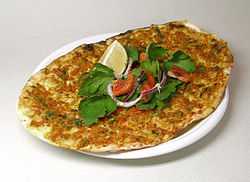
- Lahmacun - ubiquitous to the city, with the street version being substantially smaller than the regular one, and sold by higher quantity
- Çiğ Köfte Dürüm - as the name says it consists of Çiğ Köfte that has been wrapped with a lettuce leaf inside a dürüm
- Haşhaş Kebabı - a local variation of the Kıyma Kebabı, very popular in Aleppo as well, that is made by hand-mincing the meat in a thinner manner than the classic recipe, and by adding crushed garlic into the mixture.
- Ciğer dürüm - sold everywhere in the streets of the city and even eaten for breakfast, it consists of 8 skewers of charcoal grilled lamb liver and tail fat, marinated with Urfa pepper wrapped in a dürüm with cumin, sumac and onions.
- Yürek dürüm - the same wrap as the Ciğer dürüm, but with lamb heart instead of the liver, eaten the same way, slightly seasoned with paprika.
- Böbrek dürüm - 8 skewers of unseasoned lamb kidneys, wrapped with onions and sumac.
North America
Barbados
In Barbados, fishcakes are a common street food. Fishcakes are made with bits of saltfish, seasoned and mixed with flour and then deep fried. Fishcakes are sold at community events such as school fairs and concerts and can also be found at fish fries such as those in Baxter's Road in the capital city of Bridgetown or the Friday evening event in the southern fishing town of Oistins. Fishcakes are commonly eaten with saltbread, a thick, round bread; the sandwich is called a "bread-and-two" and can be found at most village shops throughout the island.
Canada
While most major cities in Canada offer a variety of street food, regional "specialties" are notable. While poutine (french fries with gravy and cheese curds) is available virtually everywhere across the country with thousands of different flavours and combinations. Similarly, hot dog stands can be found across Canada, but are far more common in Ontario (often sold from mobile canteen trucks, usually referred to as "chip wagons") than in Vancouver or Victoria (where the "Mr. Tube Steak" franchise is notable). Originating in Montréal, the Steamé is a different type of sausage than the traditional hot dog found elsewhere, it is steamed. A more expensive version is called the toasté and is toasted. These types of sausage have spread across the country to some degree but they remain most popular in Montréal. Falafel and pizza slices are foreign dishes that are popular nationwide, to varying degrees in different cities. Shawarma is quite prevalent in Ottawa, while Halifax offers its own unique version of the Doner kebab called the Donair, which features a sauce, made from condensed milk, sugar, and vinegar. The donair has spread across the country in pizza chains and other fast food restaurants. Also originating in Halifax, and now having spread somewhat are garlic fingers, a pizza-like dish with baked dough, cheese, and garlic but no tomato sauce and a different crust. Ice cream trucks can be seen (and often heard) nationwide during the summer months.Corn on the Cob is found commonly as well, often grilled, particularly at country fairs. British influence is seen nationwide with the very popular fish and chips often sold at chip wagons. Crêpes are also found, with sweet or savoury fillings. A growing trend has seen the emergence of grilled cheese becoming popular as a street food as of late.
In terms of desserts, butter tarts are extremely popular, as are nanaimo bars. Very popular as well as BeaverTails, a fried dough pastry originating in Ottawa. Vendors also sell fruits and nuts during the summer months and some move indoors, particularly to train stations during the harsh winter months.
Unique Canadian street foods
-
- Poutine
- Montreal hot dog
- Donair
- Butter tart
- Nanaimo bar
- BeaverTails
Dominican Republic
Fried foods are common in the Dominican Republic. Empanadas are a very typical snack, made of fried flour, though empanadas made out of cassava flour, called catibias, are also common. Fillings include cheese, chicken, beef, and vegetables, or a combination of these. Yaniqueques are sold at many empanada stands. Yaniqueques (from Jonnycake) are essentially round flour shaped cakes which are fried and usually eaten with salt and/or ketchup. Other vendors sell plantain fritters and fried or boiled salami.
Hamburgers are sold at stands called chimis, which also offer sandwiches called chimichurris, though these bear little to no resemblance to the South American sauce of the same name. Chimis occasionally also offer hot dogs and other sandwich varieties.
Corn on the cob can be bought on the street, usually sold by traveling vendors who move around on a tricycle. Sweets vendors who sell treats such as candied coconut and dulce de leche sell their goods at major intersections in cities and sometimes have their own stand. Often, fruit vendors also prepare platters of chopped pineapple, mango, banana and/or papaya topped with honey or syrup.
Haiti
In Haiti street vendors sell dishes such as fried plantains, griot (deep-fried pork or beef), frescos (fruit soda drink), cassava bread, pig's ears,[26] and Haitian patties (pastry filled with choice of chicken, fish, beef, or pork).
Jamaica
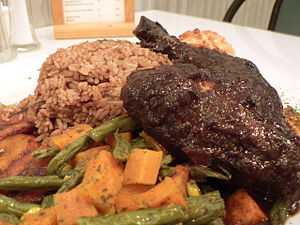
The most common Jamaican street food is jerk chicken or pork and can be found everywhere on the island. Jerk is marinade that is a blended primarily from a combination of scotch bonnet peppers, onions, scallions, thyme and allspice. Once marinated, it is often barbecued on converted steel drum or whatever else locals can construct as a grill/smoker. It is often accompanied with breadfruit and/or festival, a sweetened fried dough.
Meat patties in a yeast bread called "coco bread" are the most popular street food. At Easter, bun and cheese is also eaten as a popular snack.
Mexico
In Mexico, there is a great variety of antojitos Mexicanos that are found at street food vendors, at any time of night or day: tacos, tortas (traditional Mexican sandwiches), tostadas, picadas, quesadillas, guaraches, panuchos, sopes, gorditas, tamales, atole, aguas frescas, and cemitas.
Puerto Rico
Puerto Rico is well known for its street foods (referred to collectively as cuchifritos in New York City) and is popular both in the Caribbean and in mainland North America. Typical Bastreet foods include pinchos (a kebob of skewered pork, seafood or chicken, usually spicy and topped with barbecue sauce on bread; often fried whole).
Empanadas are very popular. Fried flour or yuca flour pastries stuffed with chicken, ground meat, potatoes, corn, fruit, cheese, or seafood. There are also combinations such as cheese with meat, cheese with fruit, potatoes with meat, even pigeon peas with coconut and pizza empanadas.
There's the papa rellena, fried potato balls stuffed with meat or cheese.
Alcapurria, masa made from cassava or traditional taro with green banana. The masa is filled with meat or seafood. The masa can also contains a small amount of potatoes, plantains, and/or calabazas (tropical pumpkins). Picadillo is the typical stuffing.
There are also arepas stuffed with fried meat, seafood salad or usually seafood cooked in coconut milk if one likes.
Dishes based on plantains or green bananas are popular as street food throughout Puerto Rico. Pasteles are a combination of mashed tubers, plantains, or bananas filled with pork and wrapped in banana leaves and then boiled. Pionono a sliver or ripe plantain sliced down the middle, fried and then stuffed with ground meat, cheese, raisins, capers, and olives. Plátano relleno similar to papa rellena but with ripe plantains rather than potatoes.
Bacalaítos are a fried pancake-like dough that are served with salted codfish. These foods can be found on the side of just about any busy street, but also typically in kiosks, often near the beach.
Sorullos a fried cornmeal batter shaped like fat fingers; they can be sweet or savory. Sorullos are stuffed with Puerto Rican white cheese, Cheddar or mozzarella and is served with Russian dressing. Sweet sorullos contain sugar and are filled with Puerto Rican white cheese and fruit paste such as goiabada.
Arañitas get their name from their shape, a play on araña, or spider. These shredded green plantain fritters are mixed with mashed garlic, cilantro and fried.
Cuchifrito is about as simple a dish. Essentially, slice off a chunk of pork (the ear, the stomach, or the tail), cover it in batter, and deep-fry.
The almojábana is a fritter made flour from rice, baking soda, cheese (Creole, cheddar, or mozzarella), parmesan cheese, milk and egg. This mixture is used to make a dough that is fried into a ball. This frying is done mostly in the Western region of the island where one could find on sale in stalls, cafés and festivities.
Trinidad and Tobago
In Trinidad and Tobago there are roti and shark & bake stands that provide quick foods like roti, dhal puri, fried bake, and the most popular, Doubles. Roti is a thin flat bread originating from India that is fluffy on the inside and crispy and flaky on the outside. It is cooked on a flat iron plate called a tawah (Hindi tawa) or platain and served with curried chicken, pork or beef. Dahl puri is similar to the roti but is softer and pliable and has crushed dahl lentils cooked with saffron and placed in the centre of the dough before it is rolled out and cooked. This is also served with either curried chicken, pork or beef.
Fried bake is made by frying flattened balls of dough that becomes fluffy and increases in height as it is fried. It can be served with fried ripe plantains, meat or gravy. At the shark & bake stands fried bakes filled with well-seasoned shark fillets and dressed with many different condiments including pepper, garlic and chadon beni can also be found.
Doubles is made with two flat breads called baras (from Hindi bara, "big") that are filled with channa (from Hindi "chick peas") and topped with pepper, cucumber chutney, mango chutney, coconut chutney or bandania/chadon beni. It can be eaten either wrapped up as an easy to eat sandwich, or open it up and eat each bara separately.
United States
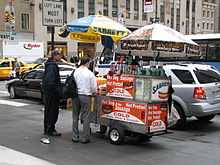
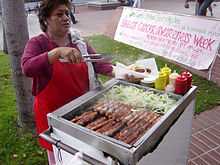
In the United States, hot dogs and their many variations (corn dogs, chili dogs) are perhaps the most common street food, particularly in major metropolitan areas such as New York City. Roasted nuts and gyros are often sold in the cities. Cheesesteaks, breakfast sandwiches, and pretzels are common in Philadelphia. Throughout the US, ice cream is sold out of trucks. Tacos and Tortas are sold from open food stalls. Pizza and egg rolls are available from window counters.
Some vendors operate out of food trucks and food carts, which offer a low overhead for entrepreneurs and often serve a huge variety of cuisines. Like restaurants, they are regulated and subject to inspections by local municipal or county health departments. Food trucks surged in popularity after the success of the Korean–Mexican fusion truck Kogi Korean BBQ in Los Angeles in 2009.[27][28] According to Smithsonian Magazine, the hip new generation of food trucks "are the new incubators of culinary innovation,"[28] with Kogi serving novel concoctions such as kimchi quesadillas, and gourmet ice cream truck Coolhaus serving inventive flavors such as Avocado Sriracha, Brown Butter Candied Bacon, and Fried Chicken & Waffles.[29][30]
Diversity and the lack of a strictly defined national cuisine means that, in most urban areas in the US and Canada, vendors sell hot dogs, pizza, falafel, gyros, kebobs, tortilla-based snacks such as tacos and burritos, panini, crêpes, french fries, egg rolls, and other various dishes.
Virgin Islands
Popular street foods in the Virgin Islands include patés, fried fish, fried chicken leg and johnnycake (fried dough). Pates, similar to the empanadas of Puerto Rico and the Dominican Republic, consist of fried flour filled with various meats, including conch, saltfish, beef, chicken and lobster.
Oceania
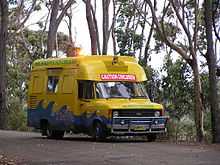
Australia
The most common street food in Australia is the sausage sizzle, usually consisting of a thin sausage or sandwich steak cooked on a barbecue and served on a slice of bread with optional fried onions, cheese, mustard and tomato or barbecue sauce. The stalls are usually run by local sporting or charity groups as fundraiser.
A pie floater is a meal served at pie carts in Adelaide and elsewhere in South Australia. It was once more widely available in other parts of Australia, but its popularity waned. It consists of an Australian meat pie covered with tomato sauce, sitting in a plate of green pea soup.
People can buy soft serve and other ice creams from vans which drive around the streets. The vans alert potential customers with a tinkling tune, for example Greensleeves or The Entertainer.
In Melbourne and Sydney, kebabs and souvlakis have taken over as the main street food due to the high percentage of Greek and Lebanese people in both cities, and is popular as a late night snack, especially after a few beers. They are known to curb late night drunken violence as punters gather around and enjoy a meal together and share stories of their night.
New Zealand
Vans selling burgers, New Zealand hotdogs (a battered sausage on a stick), toasted sandwiches and chips are the most common type of street food in New Zealand. The White Lady food van in downtown Auckland is a well-known icon of the city. There are many coffee carts and coffee vans operating the streets, both independent ones as well as vans operating as part of a franchise system such as The Coffee Guy.
Like Australia, ice cream vans and sausage sizzles are also common in New Zealand. The most well known ice cream franchise is Mr Whippy, a franchise that originally came from England, and also operates in Australia. Mr Whippy softserve icecream is an iconic symbol of a New Zealand summer to many Kiwi.
South America
Argentina
In Argentina, vendors sell Choripan, a barbequeued sausage served wrapped in French bread, or morcipan, using a blood sausage (morcilla) instead.
Pizza is very popular, in part due to the country's heavy Italian immigration in the early 20th century. Local versions include the fugazzeta, a pizza made with mozzarella cheese and onions, and the fainá: a pizza made with garbanzo bean flour with no toppings, generally served as a side dish to regular pizza.
The empanada, which in gourmet versions is baked, is usually deep-fried in this case. Empanadas can be made with beef, fish, ham & cheese, neapolitan (using the same toppings as that pizza) or vegetarian.
Sandwiches are usually served hot, like the Tostado or the Lomito, the latter having a great number of versions, with food courts offering all kinds of ingredients and combinations.
Other local street food includes local versions of the hotdog called pancho, and the hamburger or hamburguesa. Despite being very popular in the past, these have been displaced by a number of reasons, mainly a local perception that American-style foods are unhealthy and of low quality.
Sweets and desserts usually found in Argentine streets include caramel apple (manzana acaramelada), cotton candy (algodon de azucar), sweet popcorn (pochoclo) and a local snack called garrapiñada, which is made of peanuts, vanilla and sugar caramel, and sold in small bags in the shape of tubes.
Brazil
Pão de queijo, which can be translated as "cheese bread", is a street snack in the southeast of Brazil and, increasingly, the rest of the country. Hot dogs, cooked in a tomato-based sauce with bell peppers and onions, are often sold with grated cheese, ketchup, mayonnaise, green peas, corn kernels, fried potato sticks (batata palha), potato salad or mashed potatoes as choice of toppings. Hamburgers are also offered with an assortment of toppings, such as mozzarella cheese, bacon, fried eggs, lettuce, tomato, mayonnaise, ketchup and mustard, the popular "X-Tudo" (or cheese-all, a souped up cheeseburger). Calabresa (Pepperoni) sausage sandwiches are also popular.
Rio de Janeiro beach vendors sell Mate Gelado (erva mate iced-tea), biscoitos de polvilho (sour manioc flour puffs), roasted peanuts and queijo coalho (grilled cheese on sticks, barbecued on the spot) as well as popsicles, cold beer and home-made sandwiches (sanduiche natural). In the northeastern state of Bahia, the region's African heritage is reflected in the iconic acarajé (deep fried black eyed pea bun filled with caruru, made from salted dried shrimp, and vatapá, a creamy combination of coconut milk, palm oil and cashew nuts) or sweets like cocada (candied coconut) and pé-de-moleque (peanut brittle). All over the country, popcorn is always offered in push carts both savory or sweet (with sugar and cocoa powder). Churros push carts (sausage shaped deep fried dough filled with a choice of doce-de-leite caramel or chocolate sauce) are also found on any major city street.
Chile
In Chile, sopaipillas, a deep fried dough made out of flour and pumpkin, Anticucho, completo, calzones rotos, fresh fruit juices, soft drink, French fries, pizza, churros, empanadas, sweets and sweets are sold by street vendors.
Colombia
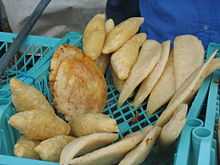
In Colombia, the empanada, a deep-fried meat-filled patty, is sold. It is also a very popular side dish. Various types of arepa are also a common street food. Also popular is the chuzo (meat skeewer), consisting of pork or chicken speared shish-kebab style on a thin wooden stake (hence the name chuzo, from chuzar meaning "to pierce or spear") and cooked over charcoal on a pushcart. Most chuzos are garnished with a small arepa at the top and a small roasted potato at the bottom. Morcilla, various sausages, and chinchurria are also sold by street vendors.
Buñuelos and natilla are popular especially during the Christmas season.
In the Paisa Region, pan de bono, pan de yuca, pan de queso, pastries and wine cake are sold at street stalls. Ice cream treats and paletas are also popular at street vendors. Fruit salad with condensed milk, granizado shakes, salpicon, and fresh fruit are also sold in the land of "eternal spring". Carimañolas are sold in coastal regions.
Peru
In Peru, anticuchos, a type of kebab, are often sold by street vendors called anticucheras. Also, cuy, a species of Guinea Pig is served as a delicacy on religious holidays.
Venezuela
In Venezuela, the arepa is a common fast-food meal. It consists of a flattened cornmeal bun, about the size and shape of an English muffin, split open and usually stuffed with soft cheese. Other fillings include shredded chicken salad with mayonnaise and avocado (reina pepiada), shredded brisket cooked with onions, red bell peppers and tomatoes (carne mechada) and pickled octopus. Also popular are cachapas, flat cakes made from fresh corn, rather than corn flour. Empanadas are also eaten in Venezuela, and are made out of corn flour, rather than wheat flour, as in the rest of the continent. They are filled with the same ingredients as arepas.
See also
References
- ↑ Artemis P. Simopoulos, Ramesh Venkataramana Bhat. Street Foods. Karger Publishers, 2000. p. vii. Retrieved 18 April 2011.
- ↑ Christopher Wanjek. Food At Work: Workplace Solutions For Malnutrition, Obesity And Chronic Diseases. Retrieved 2012-08-16.
- ↑ Dorling Kindersley. Ultimate Food Journeys: The World's Best Dishes and Where to Eat Them. Retrieved 2012-08-17.
- ↑ Nina L. Etkin (2009-09-15). Foods of Association: Biocultural Perspectives on Foods and Beverages that ... Retrieved 2012-08-17.
- ↑ Boissard (1997), p. 80
- ↑ Bradt (2011), pp. 101–102
- ↑ Donenfeld (2007), p. 7
- ↑ Chan Tat Chuen (2010), pp. 97–98
- ↑ Savoir Cuisiner (2004), pp. 18–19
- ↑ Espagne-Ravo (1997), pp. 131–132
- ↑ Jeanguyot, Michelle; Ahmadi, Nour (2002). Grain de riz, grain de vie (in French). Paris: Editions Quae. p. 87. ISBN 2-914330-33-2.
- ↑ Ranaivoson, Dominique (2007). 100 mots pour comprendre Madagascar (in French). Paris: Maisonneuve & Larose. pp. 18–19. ISBN 2-7068-1944-8.
- ↑ 13.0 13.1 Weber, Katharine (2010). True Confections. New York: Random House. p. 149. ISBN 978-0-307-39586-3.
- ↑ Pitcher, Gemma; Wright, Patricia (2004). Madagascar & Comoros. Melbourne, Australia: Lonely Planet. p. 37. ISBN 1-74104-100-7.
- ↑ "Morocco's best street food". cnn.com.
- ↑ "Boerewors". honestcooking.com.
- ↑ "Bunny chow – South Africa’s own street food". http://sundayexpress.co.ls/''.
- ↑ "Delicious Foods in Dhaka".
- ↑ "Shanghai Should Keep Its Promise to Vendors". China Daily. May 23, 2007. Retrieved 2009-02-13.
- ↑ Hamsini Ravi A Day in the Life of a Daabeliwala 25 June 2009Nazar
- ↑ Street food in Delhi Indian Street Food in India
- ↑ ScienceDirect.com - Food Control - Microbiology of day-old chicks: a Philippine streetfood
- ↑ Bùi Minh Đức (2009). "Tô phở Bắc và đọi bún bò Huế trên bình diện văn hóa đối chiếu" [‘Phở’ of the North and Beef Noodle of Huế as Compared Under a Cultural View]. Tạp chí Nghiên cứu và Phát triển (in Vietnamese) 1 (72). ISSN 1859-0152.
- ↑ 24.0 24.1 24.2 24.3 Kraig, Bruce (2013-09-09). Street Food Around the World: An Encyclopedia of Food and Culture. ABC-CLIO. pp. 367–. ISBN 9781598849554. Retrieved 30 March 2014.
- ↑ "Where's the best place to buy jellied eels in London? - Telegraph". The Daily Telegraph. Retrieved 9 May 2013.
- ↑ http://sakpasediplomacy.wordpress.com/2011/09/24/a-taste-of-haiti/
- ↑ Steinhauer, Jennifer (February 24, 2009). "For a New Generation, Kimchi Goes With Tacos". The New York Times (Los Angeles, CA). Retrieved October 30, 2014.
- ↑ 28.0 28.1 Gold, Jonathan (March 2012). "How America Became a Food Truck Nation". Smithsonian Magazine (Los Angeles, CA). Retrieved October 30, 2014.
- ↑ "Coolhaus menu". Coolhaus official site. n.d. Retrieved October 30, 2014.
- ↑ Steingarten, Jeffrey (July 16, 2014). "Road Food". Vogue. Retrieved October 30, 2014.
External links
-
 Media related to Street food at Wikimedia Commons
Media related to Street food at Wikimedia Commons
| ||||||||||||||||||
| ||||||||||
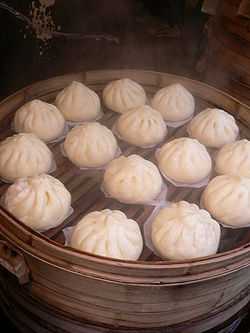

.jpg)
